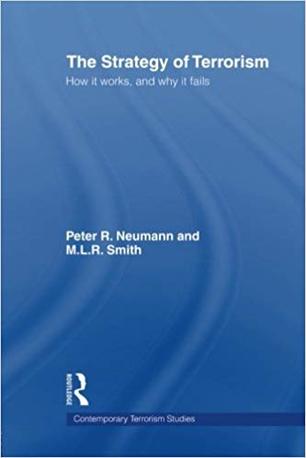Peter R. Neumann, Michael L.R. Smith, The Strategy of Terrorism. How it works, and why it fails, Routledge, New York 2008
The book tackles the problem of terrorism from an unconventional way, because it is one of the few books to set out a comprehensive framework by which to understand terrorism as a strategy. That means that, contrary to most of the research on terrorism, the phenomenon is viewed as a rational strategy to fulfill political goals. The main purpose of this book is therefore to describe the military dynamics of terrorism and evaluate their effectiveness, as well as theorize upon.
The book define terrorism as the deliberate creation of a sense of fear, usually by the use or threat of use of symbolic acts of physical violence, to influence the political behavior of a given target group. (p.8) However, unlike much of what we consider conventional warfare the aim of a strategy of terrorism is not to kill or destroy but to break the spirit and create a sensation of fear within a target group. Terrorism, therefore, is a particular form of psychological warfare. (p.9) This is the main argument of the book that is elucidated in chapter 4 and 5.
Not only the book calls into question traditional wisdom about terrorism, but it also suggests that terrorism as a tactic can be employed by state or non-state actors without a different in the strategic meaning. As a consequence, according to the authors, terrorism does not connote a weaker side confronting a more powerful adversary, because all strategies are about maximizing one’s strengths and minimizing weakness. Likewise, the methods that we associate with terrorism, such as ambushes, sabotage, bomb attacks and assassination have all been established as adjuncts of conventional warfare. Thus, from the viewpoint of strategic theory, terrorism is simply a set of tactics, a form of fighting that can intrinsically be employed by any belligerent in any type of conflict. (p. 14)
The authors elucidate on the fact that strategic literature has used several terms to describe “unconventional warfare” such as LIC (Low Intensity Conflict, guerrilla, asymmetric warfare and so on), but in doing so individual wars have been de-contextualized from their historical, geographical and politically contingent settings and regarded as a uniform threat to be combated through an equally universalized set of strategic and operational principles. However, the authors use Clausewitz’s ideas about war and politics to suggest that the tactics one uses (conventional war or terrorism) are to be judged only to the extent that they help or hinder the attainment of objectives. (p. 28)
Chapter 3 delineates the modus operandi of strategic terrorism in three stages: 1) disorientation, terrorism seeks to alienate the authorities from their citizens by reducing the government to impotence in the eyes of the population and creating impression that those in power are unable to cope with a situation of evolving chaos; 2) target response that aims to induce the government to respond in a manner that is favorable to the insurgent cause; 3) gaining legitimacy serves to exploit the emotional impact of the violence to insert an alternative political message as well as broaden the terrorist’ support base, often through the media or political front organizations.
The first goal of strategic terrorism
is not win “hearts and minds”, but it is to disorientate people through
acts of symbolic violence. This kind of strategy has been successful
where the target government was an occupying power. Insurgent groups who
have chosen to employ strategic terrorism enjoy two important
advantages when confronting an occupying power: 1) a foreign enemy
allows for a less-discriminate targeting policy; 2) the group could
attack both the occupied territories and the colonial metropolis, (p.
37) thus, broadening both the number of possible targets (and way of
attacks) and its audience.
However, in spite of the horrific images
of carnage, the statistics show that terrorist acts kill much fewer
people than some so-called conventional strategies. Central to any
strategy of terrorism, then, is the manipulation of the psychology of
fear through a systematic campaign of violence, but people learn to cope
with violence so repetition may not amplify the effect of
disorientation but it may lead to a normalization or indifference that
helps to explain why strategic terrorism often fails.
The
book is very interesting and it takes a very different point of view on
terrorism that helps to better understand the phenomenon. The strategic
analysis applied to terrorism is original, intriguing as well as
crucial in order to understand terrorism and overcome traditional
shortcomings related to psychological, sociological and similar
approaches.
However, throughout the book the authors often suggest
that strategic terrorism is not the same as insurgency and guerrilla
warfare, but they do not distinguish the phenomena and moreover, they
correctly state that terrorism is about fear not “winning hearts and
minds”, so terrorism does not aim at rousing the people, but then they
say that without a popular support terrorism is doomed to fail. The
latter is an embraceable idea but it could partially invalidate the
notion of strategic terrorism.


2 thoughts on “The Strategy of Terrorism. How it works, and why it fails”